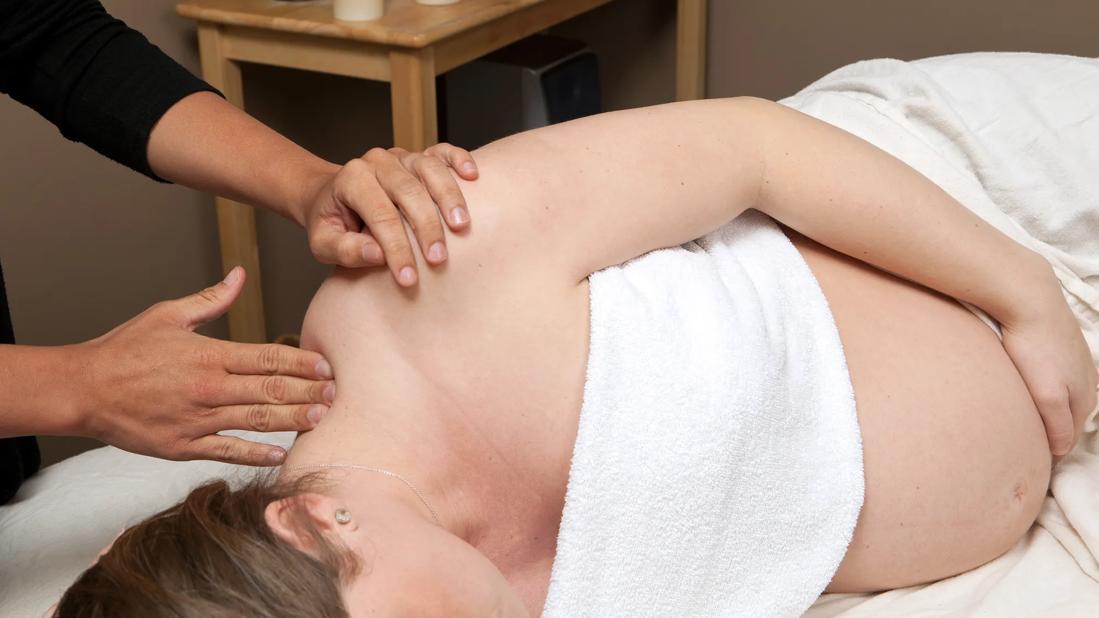Considering a Prenatal Massage? Here’s What To Know
Prenatal massage, done properly, is a safe and effective way to lower stress and relieve pregnancy discomforts

A good massage is like hitting the trifecta of self-care: It can reduce stress, relieve aches and pains, and feel like the ultimate indulgence.
And when you’re pregnant, the benefits of a prenatal massage can be amplified even more.
Licensed massage therapist DeBorah Hill, RN, LMT, explains what to expect from a prenatal massage, what to avoid and what it can do for you.
What is prenatal massage?
Prenatal massage is a self-care and complementary medicine practice that can help relieve the emotional and physical discomforts of pregnancy.
Prenatal massage allows you to get all those feel-good benefits of massage in a pregnancy-safe practice. That can include massage techniques like:
- Swedish massage
- Myofascial release therapy
- Craniosacral therapy
“Prenatal massage is all about using very gentle massage techniques that are effective with pain relief and discomfort,” Hill says.
What to expect during a prenatal massage
In a lot of ways, a prenatal massage is much like a traditional therapeutic massage, but with a few pregnancy-safe modifications.
“A prenatal massage is generally going to use very light pressure — no more than firm to medium pressure,” Hill explains.
In other words, don’t expect the kind of deep tissue massage used to release tough knots. “Prenatal massage shouldn’t cause any discomfort. We’re not looking to dig in deep,” she adds.
Also, unlike a traditional massage, prenatal massages are typically done while you lie on your side. Some pregnancy-specific props can help keep you comfortable and make sure your body is properly aligned. That can include things like pillows and firm cushions (bolsters) to help keep you comfortable.
Prenatal massages generally last anywhere from 15 minutes to an hour. As with other massage practices, you can be as covered (or as bare) as you choose.
“During a prenatal massage, you’re covered by sheets and a blanket,” Hill further explains. “Some people completely undress. Others prefer to wear pregnancy drapes (sheets and blankets) because they’re more movable. Some people prefer to stay in their undergarments. Whatever is comfortable to you should be OK with your provider.”
When should you get a prenatal massage?
Hill says most pregnancy providers usually recommend waiting until the beginning of the second trimester (12 weeks pregnant and beyond) to get a prenatal massage.
“Waiting until you’re out of your first trimester is advisable,” Hill says. “Limiting or avoiding massage during early pregnancy when miscarriage rates are highest is considered the safest route.”
Once your pregnancy is into the second trimester, the more massages the merrier.
Hill recommends getting a massage once every two weeks for maximum benefit. As you hit the end of the third trimester and the discomforts add up, you can get a massage up to once a week.
Benefits of prenatal massage
Prenatal massage can be soothing, and it can also offer multiple health benefits. A review of research suggests it may help:
- Reduce stress
- Ease back and leg pain
- Lower depression and anxiety
- Increase your immune response
- Raise levels of “happy hormones” (like serotonin and dopamine, which can help to elevate your mood)
- Improve delivery outcomes, including a higher birth weight and lower risk of preterm delivery
“Whether you’re pregnant or not, getting a massage may decrease stress hormones and spur production of oxytocin,” Hill reports. “Oxytocin is known to help improve labor contractions and influence your bonding with your baby.”
Are there any risks?
The risks of prenatal massage from a licensed massage therapist are minimal for most healthy pregnancies, especially after the first trimester.
To ensure your safety and promote a healthy pregnancy, your therapist should follow these safety guidelines:
- Light pressure: Again, pregnancy isn’t the time for a rough-and-tumble massage. “If you’re pregnant and have blood clots, deep pressure can potentially dislodge them,” Hill warns. Deep pressure can also negatively affect your blood pressure while you’re pregnant.
- Side-lying: Lying on your stomach or back raises the risk of low blood pressure and could put pressure on your nerves. And while some massage therapists have special pregnancy massage tables with a hole cut out so you can lie down on your stomach, it’s generally safest to have a prenatal massage while lying on your side.
- Pregnancy complications: Always check with your pregnancy provider before getting a prenatal massage. They may not recommend it if you have pregnancy concerns like gestational diabetes, high blood pressure and other conditions.
If you’re cleared by your healthcare provider, choose a reputable massage therapist who’s trained to provide prenatal massage. And get ready to enjoy the perks of some you-time.
“During pregnancy, so many things are limited — from foods and drinks to activities you enjoy and even certain medications,” Hill recognizes. “Prenatal massages are something you can do to help yourself feel your best.”